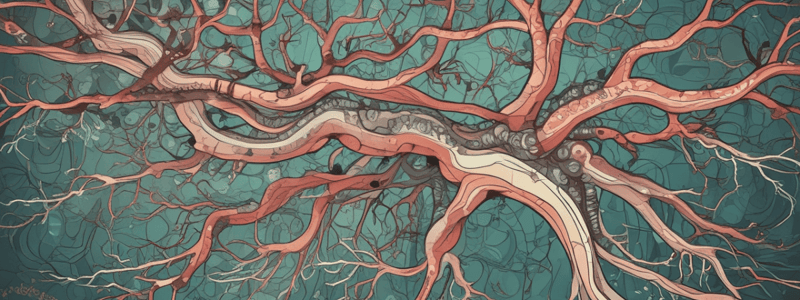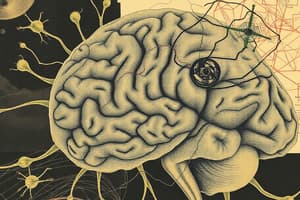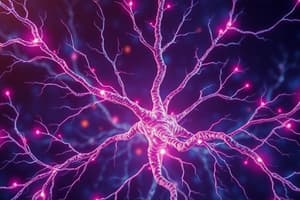Podcast
Questions and Answers
Which type of glia forms myelin in the CNS?
Which type of glia forms myelin in the CNS?
- Microglia
- Astrocytes
- Ependyma
- Oligodendrocytes (correct)
Which cells have astrocyte-like functions in the gastrointestinal tract?
Which cells have astrocyte-like functions in the gastrointestinal tract?
- Satellite cells
- Enteric glia (correct)
- Ependyma
- Schwann cells
What is the primary role of microglia in the CNS?
What is the primary role of microglia in the CNS?
- Lining the ventricles
- Acting as immune cells (correct)
- Forming myelin
- Providing metabolic support
Which cells are involved in the uptake of neurotransmitters in the CNS?
Which cells are involved in the uptake of neurotransmitters in the CNS?
What prevents harmful substances in the blood from entering the brain?
What prevents harmful substances in the blood from entering the brain?
Which type of neuron-supporting cell is found in the PNS and has myelinating and non-myelinating forms?
Which type of neuron-supporting cell is found in the PNS and has myelinating and non-myelinating forms?
Why do neurons in the PNS regenerate more successfully than those in the CNS?
Why do neurons in the PNS regenerate more successfully than those in the CNS?
Which cells are phagocytic and act as immune cells in the CNS?
Which cells are phagocytic and act as immune cells in the CNS?
What is a consequence of demyelination in CNS and PNS?
What is a consequence of demyelination in CNS and PNS?
Which protein forms the cytoskeleton of astrocytes and gives the brain its structure?
Which protein forms the cytoskeleton of astrocytes and gives the brain its structure?
What is the primary role of astrocytes in the context of the Glutamate-Glutamine Shuttle?
What is the primary role of astrocytes in the context of the Glutamate-Glutamine Shuttle?
What is the most common cause of excitotoxicity?
What is the most common cause of excitotoxicity?
Which demyelinating disease affects the peripheral nervous system (PNS)?
Which demyelinating disease affects the peripheral nervous system (PNS)?
How do astrocytes help prevent unregulated neuronal activity?
How do astrocytes help prevent unregulated neuronal activity?
What is a characteristic function of astrocytes during development?
What is a characteristic function of astrocytes during development?
What role do astrocytes play in neurotransmitter regulation at synapses?
What role do astrocytes play in neurotransmitter regulation at synapses?
What is the primary function of microglia in the central nervous system?
What is the primary function of microglia in the central nervous system?
Which type of cell myelinates multiple axons in the CNS?
Which type of cell myelinates multiple axons in the CNS?
What does myelin primarily consist of?
What does myelin primarily consist of?
What is the result of myelination on nerve conduction velocity?
What is the result of myelination on nerve conduction velocity?
What would be the consequence if human optic nerves were unmyelinated?
What would be the consequence if human optic nerves were unmyelinated?
What role can microglia play in neuropathologies?
What role can microglia play in neuropathologies?
What is the ratio of axons myelinated by Schwann cells in the PNS?
What is the ratio of axons myelinated by Schwann cells in the PNS?
What biological process allows action potentials to 'jump' from node to node along myelinated axons?
What biological process allows action potentials to 'jump' from node to node along myelinated axons?
What percentage of brain energy consumption is accounted for by neurons?
What percentage of brain energy consumption is accounted for by neurons?
Which type of cells form a regeneration tube that guides and stimulates axon regrowth in the PNS?
Which type of cells form a regeneration tube that guides and stimulates axon regrowth in the PNS?
What do astrocytes convert stored glucose into when neurons need energy?
What do astrocytes convert stored glucose into when neurons need energy?
Which of the following is not a function of astrocytes?
Which of the following is not a function of astrocytes?
Which barrier contributes to the CNS being considered immune privileged?
Which barrier contributes to the CNS being considered immune privileged?
What leads to the failure of neuronal regeneration in the adult CNS?
What leads to the failure of neuronal regeneration in the adult CNS?
What condition results from a lack of PNS regeneration?
What condition results from a lack of PNS regeneration?
What is being researched to promote axon regeneration and functional recovery in the CNS?
What is being researched to promote axon regeneration and functional recovery in the CNS?
Flashcards are hidden until you start studying
Study Notes
Glial Cells
- Glial cells (neuroglia) are essential for the support and nutrition of neurons.
- They differ from neurons in that they do not receive, process, and transmit information.
Types of Glial Cells
- CNS Glial Cells:
- Astrocytes: multiple neuron-supporting functions
- Oligodendrocytes: form myelin
- Microglia: phagocytic immune cells
- Ependyma: line ventricles
- PNS Glial Cells:
- Schwann cells: myelinate and provide support to neurons
- Satellite cells: astrocyte-like functions in PNS ganglia
- Enteric glia: astrocyte-like functions in the GI tract
Blood-Brain Barrier (BBB)
- The BBB is a permeability barrier that restricts harmful substances in the blood from entering the brain.
- It is composed of endothelial cells connected by tight junctions and surrounded by astrocyte processes.
Immune Privilege
- The CNS is immune-privileged, meaning that the BBB restricts peripheral immune cells from entering the brain.
Myelin
- Myelin is a fatty substance that insulates axons and increases nerve conduction velocity.
- It is essential for nervous system function.
Microglia
- Microglia are the brain's immune cells, responsible for detecting and responding to damage.
- They can have a protective or damaging role in neuropathologies.
Astrocytes
- Astrocytes have multiple functions:
- Structure
- Neurotransmitter uptake
- Potassium uptake
- Metabolic support
- They express the intermediate filament Glial Fibrillary Acidic Protein (GFAP), which gives the brain its structure.
- They take up glutamate and recycle it, terminating action at synapses.
- They also take up potassium and regulate its levels to prevent uncontrolled neuronal activity.
Neuronal Injury
- Nerves can regenerate in the PNS but not in the CNS.
- PNS regeneration is dependent on Schwann cells, while CNS regeneration is inhibited by astrocytes.
- Research into regulating astrocytes and the inhibitory glial scar may promote axon regeneration and functional recovery in the CNS.
Clinical Connections
- Demyelination: loss of myelin leads to axonal conduction block and degeneration.
- Excitotoxicity: high levels of glutamate can cause destruction of neurons.
- Epilepsy: uncontrolled neuronal activity due to high levels of potassium.
- Multiple Sclerosis: an immune disease that involves microglia.
- Alzheimer's disease: a neurodegenerative disease that involves microglia.
- Spinal injury: paralysis can occur due to the location of the injury.
Studying That Suits You
Use AI to generate personalized quizzes and flashcards to suit your learning preferences.




